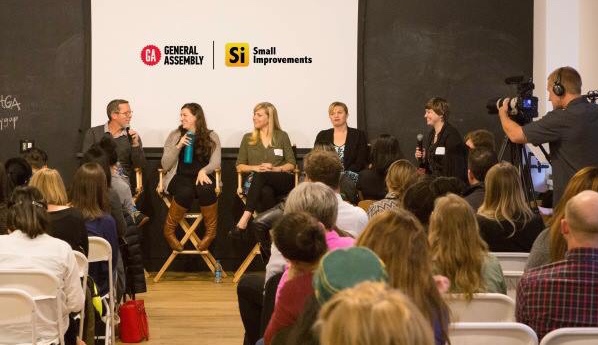Jennifer Beattie, founder of Culture on Camera, is the virtual HR sidekick for small businesses. She specializes in helping managers lead distributed teams – whether in-office, hybrid, or fully remote – and is passionate about making HR painless for companies who don’t yet need full-time HR staff. She recently sat down with us to share her tips and tricks for managing performance at a distance – read on to learn more about her recipe for success!
For a full recap of the interview, watch the recording here.
What do you say to those smaller companies that might think a formal performance review or formal feedback channels are overkill for a team of their size?
If you don’t have a pulse on everyone’s performance, it’s going to hit your bottom line. Many companies respond to business challenges by saying, “We need to hire, hire, hire—” but they don’t actually know the performance of their existing team. So they start hiring, and they don’t have a high-performing team in the beginning. These companies end up paying double, sometimes triple.
If you don’t have a pulse on performance, it’s going to rear its ugly head in many different ways. You’ll quickly see the correlation between how culture and performance affect not just your bottom line, but your business sustainability overall.
If you don’t have a pulse on performance, it’s going to rear its ugly head in many different ways.
For companies that might not yet be ready for a dedicated, full-time HR leader, what are some steps they can start taking now to lay the foundation for that culture of feedback?
That’s where the fractional community like myself comes in, where you might just need 3 hours per week, and we can support payroll, we can support onboarding, we can support performance.
I think the other piece is the importance of having these feedback systems in place early on. That’s where Small Improvements comes in, as a platform dedicated and tailored to small businesses. It’s easy to manage and navigate, and the admin side is not complex at all.
I love that you are also a small business, so you can take the client feedback and be pliable. You cater to and tailor to small businesses. It’s an easy solution for them to get some form of formalized process in place and continuous feedback like the Anytime Feedback tool.
I love that you are also a small business, so you can take the client feedback and be pliable.
In all of my one-on-ones with leaders, I have them pull up Small Improvements and say, “What feedback do you have today?” And we enter it right then and there because it needs to become part of the routine.
For companies going about their very first formal Performance Review, what are some of the common pitfalls you’ve seen, and how can they be avoided?
Not understanding what questions to ask! If you don’t plan out your questions very strategically, we get a bunch of feedback that is not actionable. So, I like to make sure that the questions are pinpointed to what we can actually take action on. If you ask, for example, “What are 3 goals that you should be meeting within the next 90 days?”—and then no one follows up on those goals—that is going to create a really negative employee experience.
And then the second piece is numbers. One thing I love about Small Improvements is that the numerical ratings have really good definitions tied to them. I think numbers can be very abstract for people, and so a “3” for one organization might be a “5” for another. You have to be abundantly clear on what those numbers mean. Because if there’s one thing people are sensitive about, it is that ranking. They tie their personal value to a number. That was helpful on the Small Improvements side – making those numbers more definable and tangible.
You like to incorporate a few fun questions to get those creative juices flowing and turn the performance review into more than just a ticking-the-box exercise. Can you speak to how you make the Performance Review more engaging?
If you’ve been in the professional world for over a year, you know a Performance Review, many of which are SO boring. As an HR Consultant, I can say that they are horribly boring, and a lot of the time, you’ll get equally boring responses.
As a tactic to get employees thinking and to make them laugh a little bit, I like to craft the questions uniquely, aiming for the same answer but worded in a way that allows employees to have a little bit of fun with it.
In upward feedback, I might ask, “If this leader’s management style were a recipe, what’s the key ingredient they always include?” It’s getting to their strengths and weaknesses, but getting them to think differently. My goal is to have people look forward to what craziness and chaos are going to be asked of them next.
I think a lot of performance reviews can be more fun, more entertaining, more engaging, and that makes it a little bit less like a check-the-box process and more valuable for both parties.
I think a lot of performance reviews can be more fun, more entertaining, more engaging, and that makes it a little bit less like a check-the-box process and more valuable for both parties.
Without those face-to-face interactions and those nonverbal cues, it can be hard for leaders to gauge employee sentiment. How can leaders get a Pulse on employee engagement in a remote or hybrid setting? And if they find that engagement is not where they want it to be, what are some steps they can take right away to improve it?
If you think about the personal connections that we make in office, we have to emulate that same engagement in a Slack community, or whatever communication platform that you have. You should be prompting people to share pictures and try to understand a little bit more about the human behind the number.
One thing that I’m a stickler on: I love being camera-on. That’s one area where we can say that remote work has a leg up on in-office work, because where else are you going to see a cat flying across the screen and be able to ask what their name is? It creates a connection on screen.
Plus, I always have my leaders do a Friday check-in where leaders ask three questions.
Number One: What was your biggest win for the week? Let’s go ahead and throw that on the kudos board.
Number Two: What is on your to-do list that I can support you with next week? For many people, having something lingering on that to-do list is probably going to weigh on them a little bit over the weekend. So, setting the expectation for Monday that you will be supported is a good way to build that connection.
The last question is: What are you doing this weekend? It’s amazing if you come back on Monday and can remember what your employee was doing over the weekend. It’s like, “Oh, you care about me as a human.”
So there are tiny little things like that that you can implement, things you don’t necessarily need to do in an office.
It’s amazing if you come back on Monday and can remember what your employee was doing over the weekend. It’s like, “Oh, you care about me as a human.”
For a remote employee who doesn’t feel aligned with their manager on expectations, what tips do you have for initiating those potentially tricky conversations and building that alignment?
I would definitely ask for more consistent one-on-ones. I’m a huge advocate of one-on-ones. In my opinion, the employee should own the one-on-one. It’s the employee’s opportunity to hold your manager hostage for 30 minutes. and you can create that agenda and say, “Hey, here’s what I’ve done. What is your opinion on what I should prioritize right now?”
I’m going to continue bragging about Small Improvements. The one-on-one tool is great because that team member can come in and craft that agenda, create those action items, and lead the meeting. Oftentimes, if you take that proactive ownership, you’ll see a great respect come out of that.
When it comes to high-performing remote employees, what are some strategies for leaders to make sure that they are getting the recognition they deserve?
It’s important to note that high-performing employees need growth opportunities and that you need to know their motivators.
We all have work-love languages, and how you recognize someone for performance is very tied to the individual. So some people are motivated by leaving early on Fridays and more work-life balance. Others want a raise in their paycheck. I think the thing that leaders get stuck on is that they force their motivators on others. You have to know your team’s work-love languages and how they need to be empowered.
Thank you so much for your time and for sharing some of your tips and tricks from your experiences in the field. Is there anything else you want to add before we go?
I appreciate everything that Small Improvements has done for my clients. We truly love the platform. I always use it as a tool for training and coaching during my one-on-ones with leadership. I appreciate everything that you are doing for small businesses. It’s really a great tool for them.
Stay connected with Jennifer and the Culture on Camera team by visiting their website or following them on LinkedIn.



